Financial Behaviour: Investment Policy Statement Report Analysis
VerifiedAdded on 2023/02/01
|8
|1879
|32
Report
AI Summary
This report presents an Investment Policy Statement (IPS) prepared for Mr. and Mrs. Ford, focusing on their financial goals and investment strategies. The IPS begins with a background of the Fords, who are approaching retirement and have specific income and expense profiles. Their objectives include securing an annual return to maintain their lifestyle, funding their son's wedding, and setting aside funds for holidays and emergencies. The report assesses their risk tolerance, recommending a moderate approach with a mix of growth and risk-free investments. A detailed cash flow analysis projects their income and expenses over five years, considering inflation. Constraints such as time horizon, liquidity, and taxes are also addressed, along with asset allocation strategies. The recommended approach involves a 30% growth fund investment strategy. The report concludes by emphasizing the importance of reviewing the information and ensuring it aligns with the Fords' financial expectations, offering a comprehensive framework for their retirement planning and investment management.
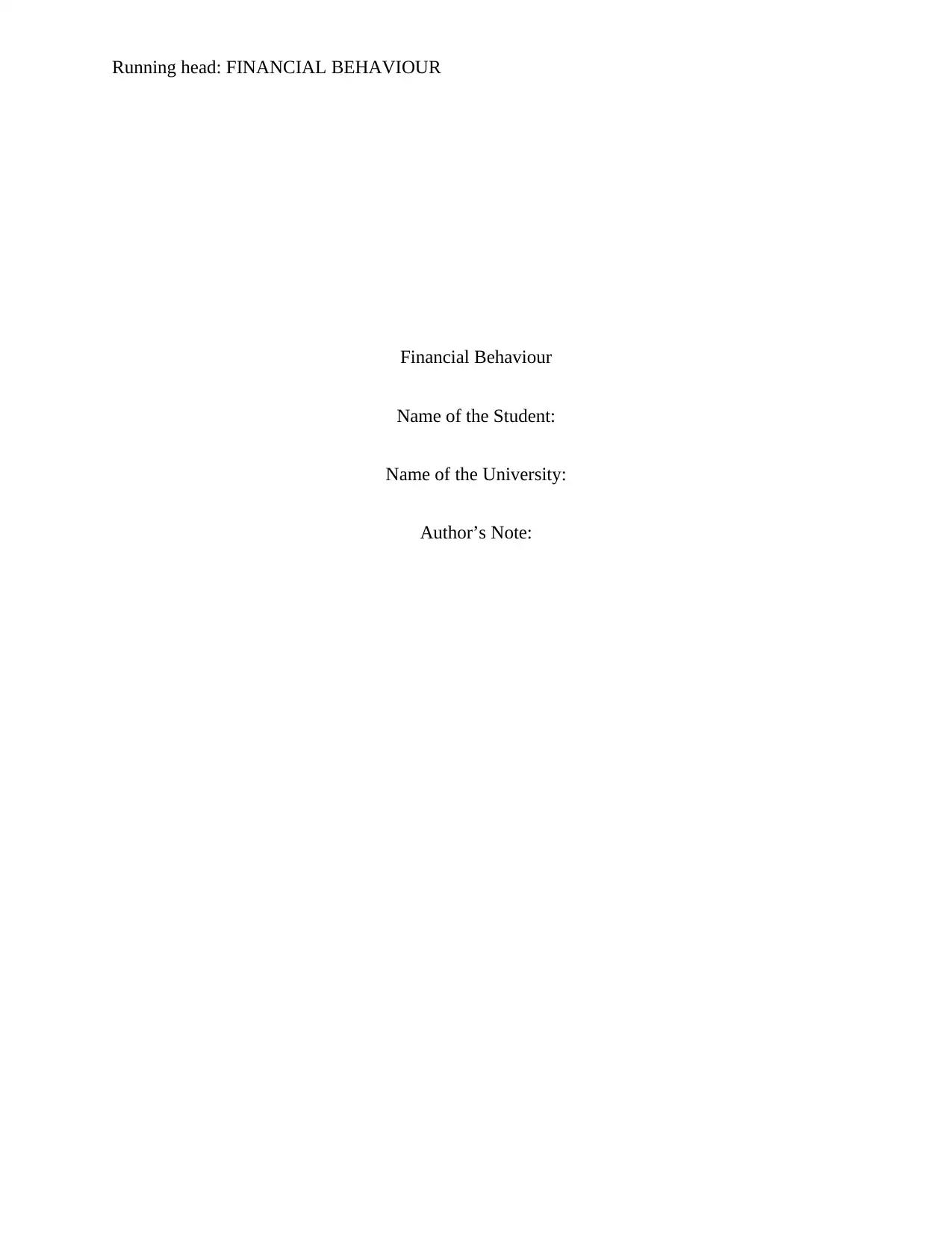
Running head: FINANCIAL BEHAVIOUR
Financial Behaviour
Name of the Student:
Name of the University:
Author’s Note:
Financial Behaviour
Name of the Student:
Name of the University:
Author’s Note:
Paraphrase This Document
Need a fresh take? Get an instant paraphrase of this document with our AI Paraphraser
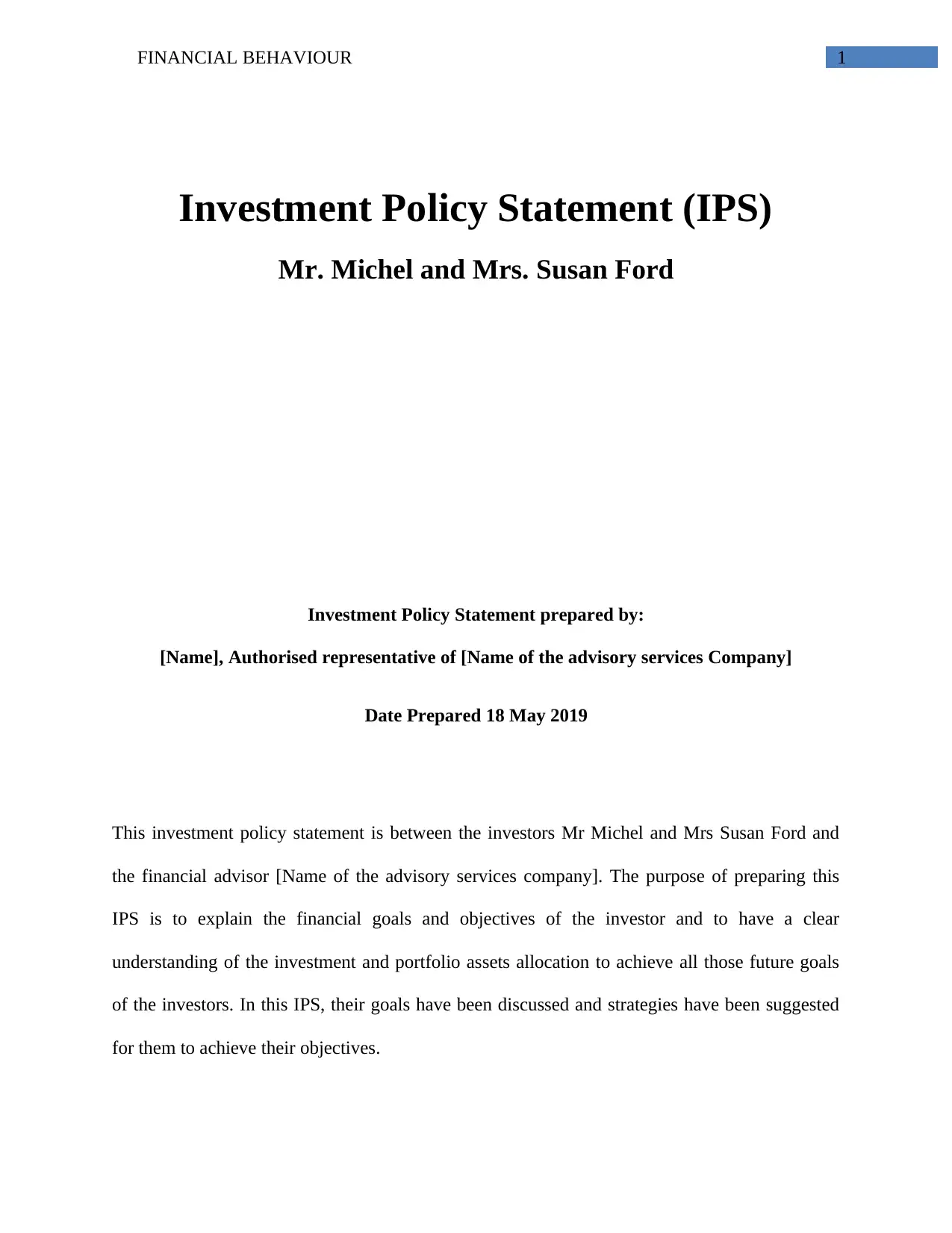
FINANCIAL BEHAVIOUR 1
Investment Policy Statement (IPS)
Mr. Michel and Mrs. Susan Ford
Investment Policy Statement prepared by:
[Name], Authorised representative of [Name of the advisory services Company]
Date Prepared 18 May 2019
This investment policy statement is between the investors Mr Michel and Mrs Susan Ford and
the financial advisor [Name of the advisory services company]. The purpose of preparing this
IPS is to explain the financial goals and objectives of the investor and to have a clear
understanding of the investment and portfolio assets allocation to achieve all those future goals
of the investors. In this IPS, their goals have been discussed and strategies have been suggested
for them to achieve their objectives.
Investment Policy Statement (IPS)
Mr. Michel and Mrs. Susan Ford
Investment Policy Statement prepared by:
[Name], Authorised representative of [Name of the advisory services Company]
Date Prepared 18 May 2019
This investment policy statement is between the investors Mr Michel and Mrs Susan Ford and
the financial advisor [Name of the advisory services company]. The purpose of preparing this
IPS is to explain the financial goals and objectives of the investor and to have a clear
understanding of the investment and portfolio assets allocation to achieve all those future goals
of the investors. In this IPS, their goals have been discussed and strategies have been suggested
for them to achieve their objectives.
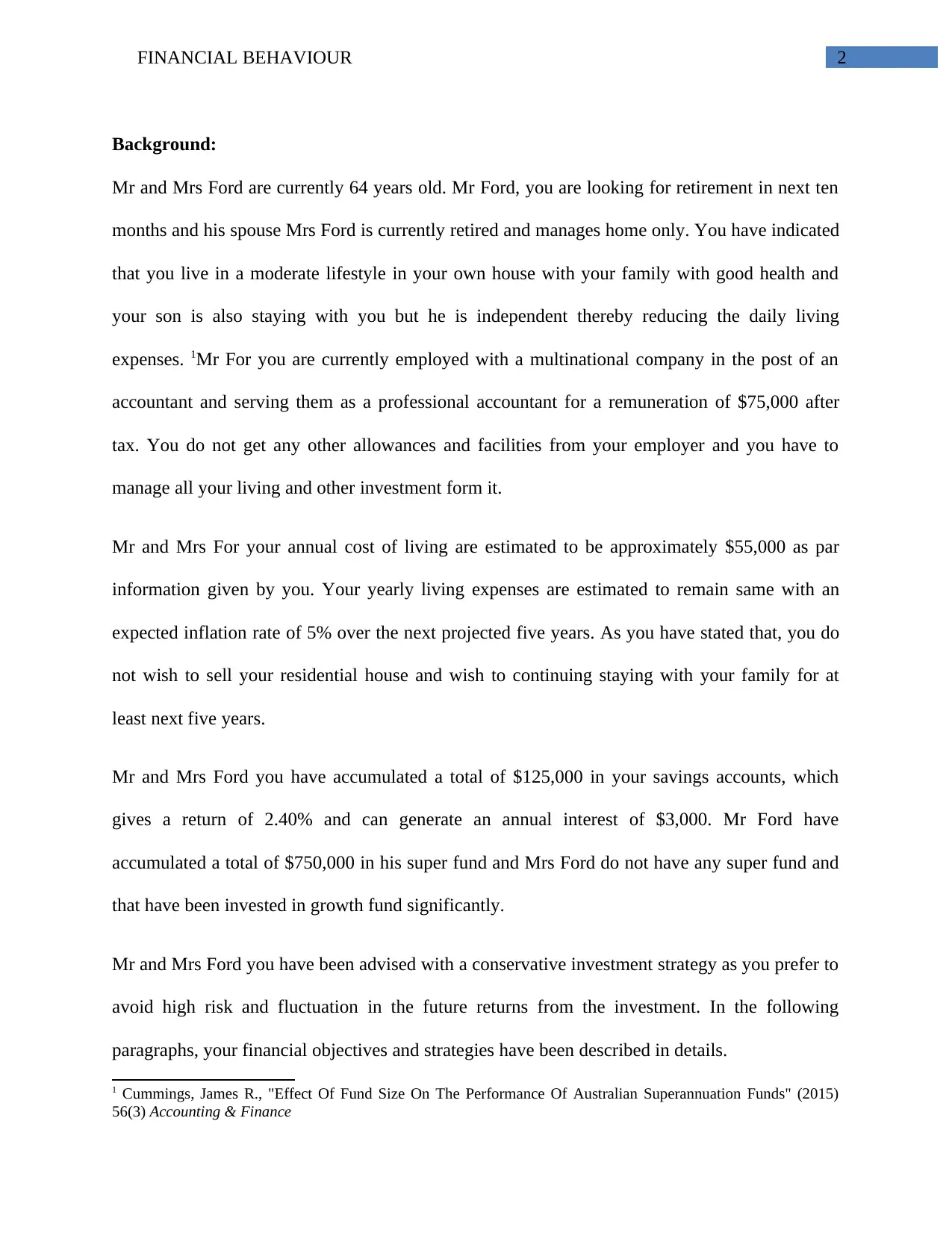
FINANCIAL BEHAVIOUR 2
Background:
Mr and Mrs Ford are currently 64 years old. Mr Ford, you are looking for retirement in next ten
months and his spouse Mrs Ford is currently retired and manages home only. You have indicated
that you live in a moderate lifestyle in your own house with your family with good health and
your son is also staying with you but he is independent thereby reducing the daily living
expenses. 1Mr For you are currently employed with a multinational company in the post of an
accountant and serving them as a professional accountant for a remuneration of $75,000 after
tax. You do not get any other allowances and facilities from your employer and you have to
manage all your living and other investment form it.
Mr and Mrs For your annual cost of living are estimated to be approximately $55,000 as par
information given by you. Your yearly living expenses are estimated to remain same with an
expected inflation rate of 5% over the next projected five years. As you have stated that, you do
not wish to sell your residential house and wish to continuing staying with your family for at
least next five years.
Mr and Mrs Ford you have accumulated a total of $125,000 in your savings accounts, which
gives a return of 2.40% and can generate an annual interest of $3,000. Mr Ford have
accumulated a total of $750,000 in his super fund and Mrs Ford do not have any super fund and
that have been invested in growth fund significantly.
Mr and Mrs Ford you have been advised with a conservative investment strategy as you prefer to
avoid high risk and fluctuation in the future returns from the investment. In the following
paragraphs, your financial objectives and strategies have been described in details.
1 Cummings, James R., "Effect Of Fund Size On The Performance Of Australian Superannuation Funds" (2015)
56(3) Accounting & Finance
Background:
Mr and Mrs Ford are currently 64 years old. Mr Ford, you are looking for retirement in next ten
months and his spouse Mrs Ford is currently retired and manages home only. You have indicated
that you live in a moderate lifestyle in your own house with your family with good health and
your son is also staying with you but he is independent thereby reducing the daily living
expenses. 1Mr For you are currently employed with a multinational company in the post of an
accountant and serving them as a professional accountant for a remuneration of $75,000 after
tax. You do not get any other allowances and facilities from your employer and you have to
manage all your living and other investment form it.
Mr and Mrs For your annual cost of living are estimated to be approximately $55,000 as par
information given by you. Your yearly living expenses are estimated to remain same with an
expected inflation rate of 5% over the next projected five years. As you have stated that, you do
not wish to sell your residential house and wish to continuing staying with your family for at
least next five years.
Mr and Mrs Ford you have accumulated a total of $125,000 in your savings accounts, which
gives a return of 2.40% and can generate an annual interest of $3,000. Mr Ford have
accumulated a total of $750,000 in his super fund and Mrs Ford do not have any super fund and
that have been invested in growth fund significantly.
Mr and Mrs Ford you have been advised with a conservative investment strategy as you prefer to
avoid high risk and fluctuation in the future returns from the investment. In the following
paragraphs, your financial objectives and strategies have been described in details.
1 Cummings, James R., "Effect Of Fund Size On The Performance Of Australian Superannuation Funds" (2015)
56(3) Accounting & Finance
⊘ This is a preview!⊘
Do you want full access?
Subscribe today to unlock all pages.

Trusted by 1+ million students worldwide
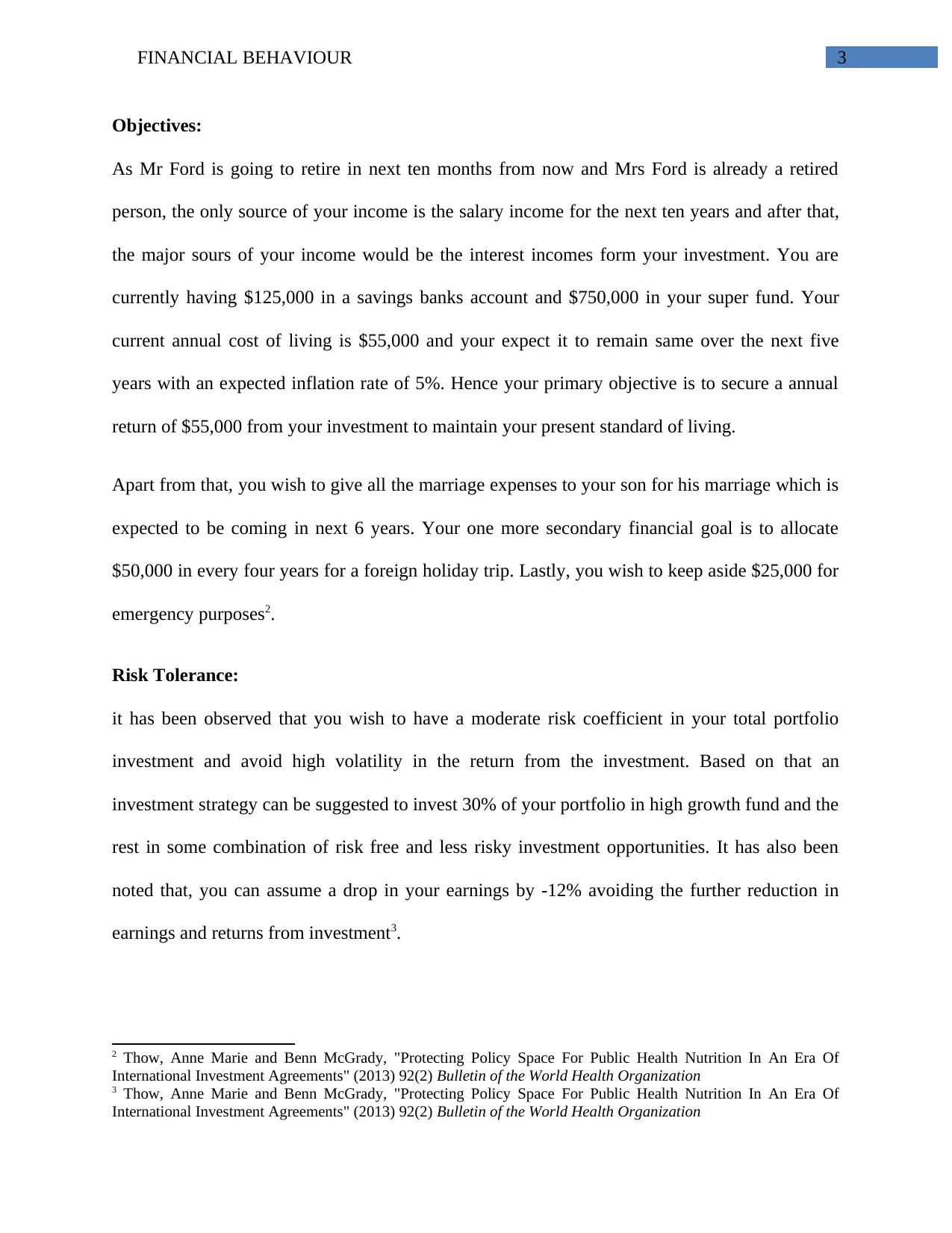
FINANCIAL BEHAVIOUR 3
Objectives:
As Mr Ford is going to retire in next ten months from now and Mrs Ford is already a retired
person, the only source of your income is the salary income for the next ten years and after that,
the major sours of your income would be the interest incomes form your investment. You are
currently having $125,000 in a savings banks account and $750,000 in your super fund. Your
current annual cost of living is $55,000 and your expect it to remain same over the next five
years with an expected inflation rate of 5%. Hence your primary objective is to secure a annual
return of $55,000 from your investment to maintain your present standard of living.
Apart from that, you wish to give all the marriage expenses to your son for his marriage which is
expected to be coming in next 6 years. Your one more secondary financial goal is to allocate
$50,000 in every four years for a foreign holiday trip. Lastly, you wish to keep aside $25,000 for
emergency purposes2.
Risk Tolerance:
it has been observed that you wish to have a moderate risk coefficient in your total portfolio
investment and avoid high volatility in the return from the investment. Based on that an
investment strategy can be suggested to invest 30% of your portfolio in high growth fund and the
rest in some combination of risk free and less risky investment opportunities. It has also been
noted that, you can assume a drop in your earnings by -12% avoiding the further reduction in
earnings and returns from investment3.
2 Thow, Anne Marie and Benn McGrady, "Protecting Policy Space For Public Health Nutrition In An Era Of
International Investment Agreements" (2013) 92(2) Bulletin of the World Health Organization
3 Thow, Anne Marie and Benn McGrady, "Protecting Policy Space For Public Health Nutrition In An Era Of
International Investment Agreements" (2013) 92(2) Bulletin of the World Health Organization
Objectives:
As Mr Ford is going to retire in next ten months from now and Mrs Ford is already a retired
person, the only source of your income is the salary income for the next ten years and after that,
the major sours of your income would be the interest incomes form your investment. You are
currently having $125,000 in a savings banks account and $750,000 in your super fund. Your
current annual cost of living is $55,000 and your expect it to remain same over the next five
years with an expected inflation rate of 5%. Hence your primary objective is to secure a annual
return of $55,000 from your investment to maintain your present standard of living.
Apart from that, you wish to give all the marriage expenses to your son for his marriage which is
expected to be coming in next 6 years. Your one more secondary financial goal is to allocate
$50,000 in every four years for a foreign holiday trip. Lastly, you wish to keep aside $25,000 for
emergency purposes2.
Risk Tolerance:
it has been observed that you wish to have a moderate risk coefficient in your total portfolio
investment and avoid high volatility in the return from the investment. Based on that an
investment strategy can be suggested to invest 30% of your portfolio in high growth fund and the
rest in some combination of risk free and less risky investment opportunities. It has also been
noted that, you can assume a drop in your earnings by -12% avoiding the further reduction in
earnings and returns from investment3.
2 Thow, Anne Marie and Benn McGrady, "Protecting Policy Space For Public Health Nutrition In An Era Of
International Investment Agreements" (2013) 92(2) Bulletin of the World Health Organization
3 Thow, Anne Marie and Benn McGrady, "Protecting Policy Space For Public Health Nutrition In An Era Of
International Investment Agreements" (2013) 92(2) Bulletin of the World Health Organization
Paraphrase This Document
Need a fresh take? Get an instant paraphrase of this document with our AI Paraphraser
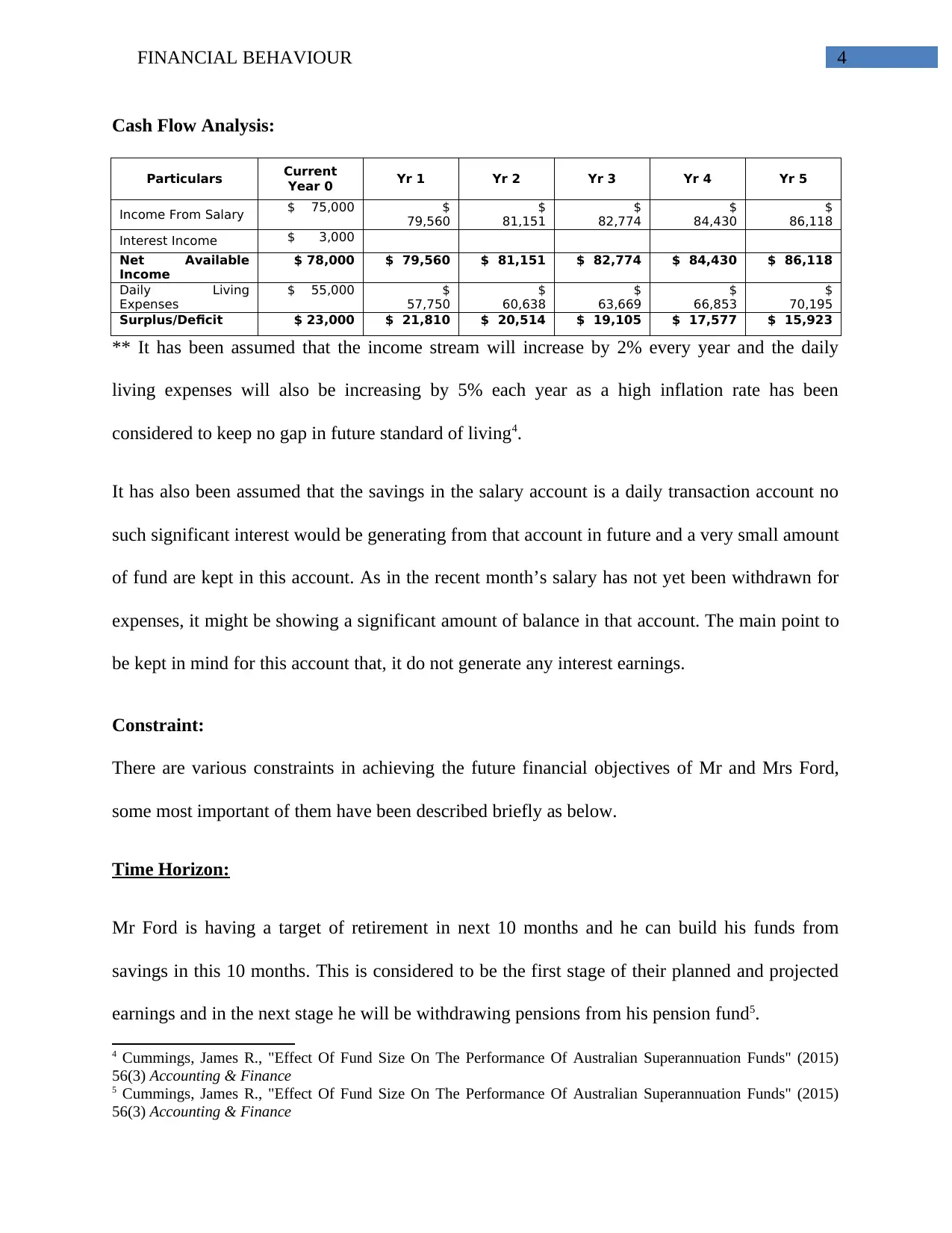
FINANCIAL BEHAVIOUR 4
Cash Flow Analysis:
Particulars Current
Year 0 Yr 1 Yr 2 Yr 3 Yr 4 Yr 5
Income From Salary $ 75,000 $
79,560
$
81,151
$
82,774
$
84,430
$
86,118
Interest Income $ 3,000
Net Available
Income
$ 78,000 $ 79,560 $ 81,151 $ 82,774 $ 84,430 $ 86,118
Daily Living
Expenses
$ 55,000 $
57,750
$
60,638
$
63,669
$
66,853
$
70,195
Surplus/Deficit $ 23,000 $ 21,810 $ 20,514 $ 19,105 $ 17,577 $ 15,923
** It has been assumed that the income stream will increase by 2% every year and the daily
living expenses will also be increasing by 5% each year as a high inflation rate has been
considered to keep no gap in future standard of living4.
It has also been assumed that the savings in the salary account is a daily transaction account no
such significant interest would be generating from that account in future and a very small amount
of fund are kept in this account. As in the recent month’s salary has not yet been withdrawn for
expenses, it might be showing a significant amount of balance in that account. The main point to
be kept in mind for this account that, it do not generate any interest earnings.
Constraint:
There are various constraints in achieving the future financial objectives of Mr and Mrs Ford,
some most important of them have been described briefly as below.
Time Horizon:
Mr Ford is having a target of retirement in next 10 months and he can build his funds from
savings in this 10 months. This is considered to be the first stage of their planned and projected
earnings and in the next stage he will be withdrawing pensions from his pension fund5.
4 Cummings, James R., "Effect Of Fund Size On The Performance Of Australian Superannuation Funds" (2015)
56(3) Accounting & Finance
5 Cummings, James R., "Effect Of Fund Size On The Performance Of Australian Superannuation Funds" (2015)
56(3) Accounting & Finance
Cash Flow Analysis:
Particulars Current
Year 0 Yr 1 Yr 2 Yr 3 Yr 4 Yr 5
Income From Salary $ 75,000 $
79,560
$
81,151
$
82,774
$
84,430
$
86,118
Interest Income $ 3,000
Net Available
Income
$ 78,000 $ 79,560 $ 81,151 $ 82,774 $ 84,430 $ 86,118
Daily Living
Expenses
$ 55,000 $
57,750
$
60,638
$
63,669
$
66,853
$
70,195
Surplus/Deficit $ 23,000 $ 21,810 $ 20,514 $ 19,105 $ 17,577 $ 15,923
** It has been assumed that the income stream will increase by 2% every year and the daily
living expenses will also be increasing by 5% each year as a high inflation rate has been
considered to keep no gap in future standard of living4.
It has also been assumed that the savings in the salary account is a daily transaction account no
such significant interest would be generating from that account in future and a very small amount
of fund are kept in this account. As in the recent month’s salary has not yet been withdrawn for
expenses, it might be showing a significant amount of balance in that account. The main point to
be kept in mind for this account that, it do not generate any interest earnings.
Constraint:
There are various constraints in achieving the future financial objectives of Mr and Mrs Ford,
some most important of them have been described briefly as below.
Time Horizon:
Mr Ford is having a target of retirement in next 10 months and he can build his funds from
savings in this 10 months. This is considered to be the first stage of their planned and projected
earnings and in the next stage he will be withdrawing pensions from his pension fund5.
4 Cummings, James R., "Effect Of Fund Size On The Performance Of Australian Superannuation Funds" (2015)
56(3) Accounting & Finance
5 Cummings, James R., "Effect Of Fund Size On The Performance Of Australian Superannuation Funds" (2015)
56(3) Accounting & Finance
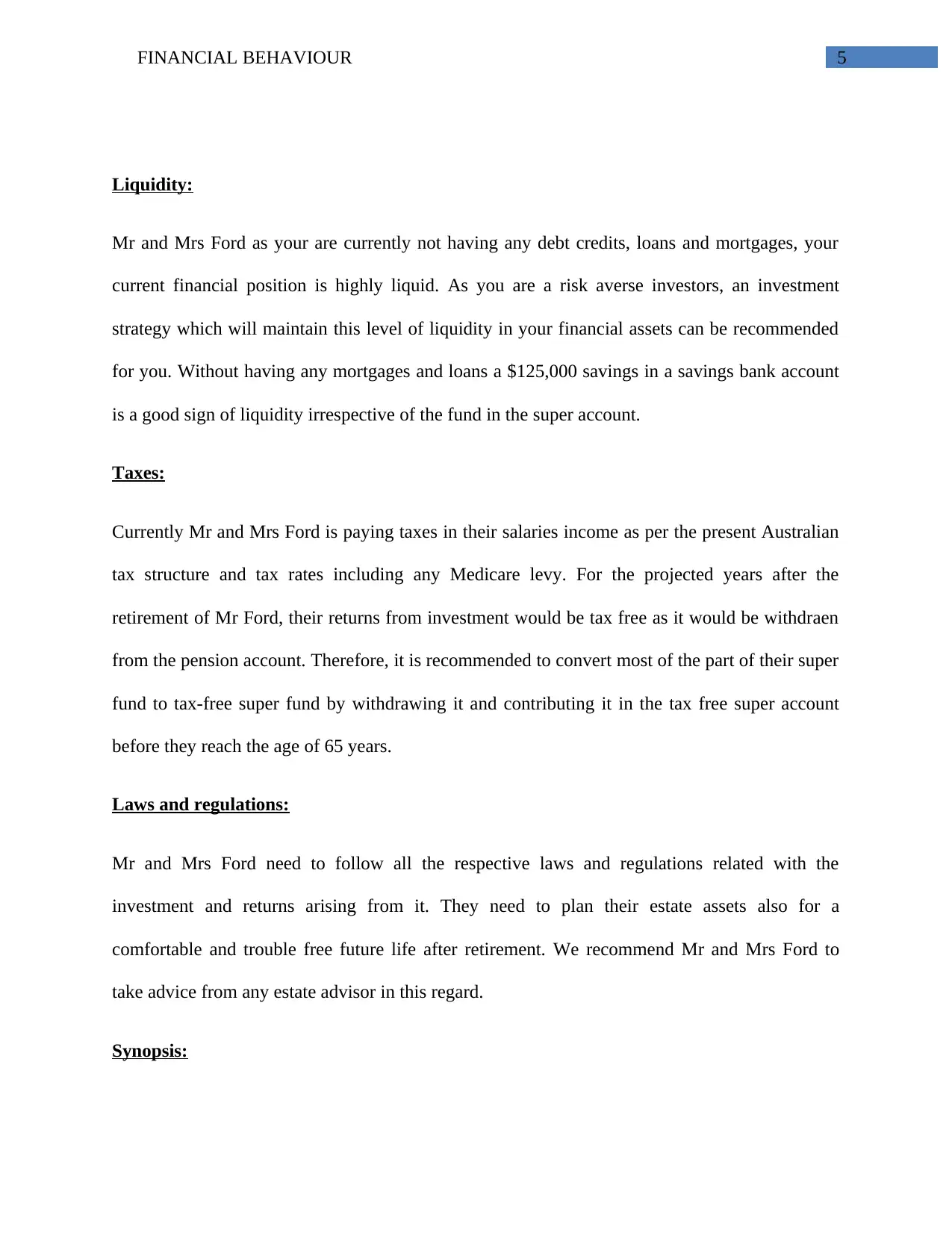
FINANCIAL BEHAVIOUR 5
Liquidity:
Mr and Mrs Ford as your are currently not having any debt credits, loans and mortgages, your
current financial position is highly liquid. As you are a risk averse investors, an investment
strategy which will maintain this level of liquidity in your financial assets can be recommended
for you. Without having any mortgages and loans a $125,000 savings in a savings bank account
is a good sign of liquidity irrespective of the fund in the super account.
Taxes:
Currently Mr and Mrs Ford is paying taxes in their salaries income as per the present Australian
tax structure and tax rates including any Medicare levy. For the projected years after the
retirement of Mr Ford, their returns from investment would be tax free as it would be withdraen
from the pension account. Therefore, it is recommended to convert most of the part of their super
fund to tax-free super fund by withdrawing it and contributing it in the tax free super account
before they reach the age of 65 years.
Laws and regulations:
Mr and Mrs Ford need to follow all the respective laws and regulations related with the
investment and returns arising from it. They need to plan their estate assets also for a
comfortable and trouble free future life after retirement. We recommend Mr and Mrs Ford to
take advice from any estate advisor in this regard.
Synopsis:
Liquidity:
Mr and Mrs Ford as your are currently not having any debt credits, loans and mortgages, your
current financial position is highly liquid. As you are a risk averse investors, an investment
strategy which will maintain this level of liquidity in your financial assets can be recommended
for you. Without having any mortgages and loans a $125,000 savings in a savings bank account
is a good sign of liquidity irrespective of the fund in the super account.
Taxes:
Currently Mr and Mrs Ford is paying taxes in their salaries income as per the present Australian
tax structure and tax rates including any Medicare levy. For the projected years after the
retirement of Mr Ford, their returns from investment would be tax free as it would be withdraen
from the pension account. Therefore, it is recommended to convert most of the part of their super
fund to tax-free super fund by withdrawing it and contributing it in the tax free super account
before they reach the age of 65 years.
Laws and regulations:
Mr and Mrs Ford need to follow all the respective laws and regulations related with the
investment and returns arising from it. They need to plan their estate assets also for a
comfortable and trouble free future life after retirement. We recommend Mr and Mrs Ford to
take advice from any estate advisor in this regard.
Synopsis:
⊘ This is a preview!⊘
Do you want full access?
Subscribe today to unlock all pages.

Trusted by 1+ million students worldwide
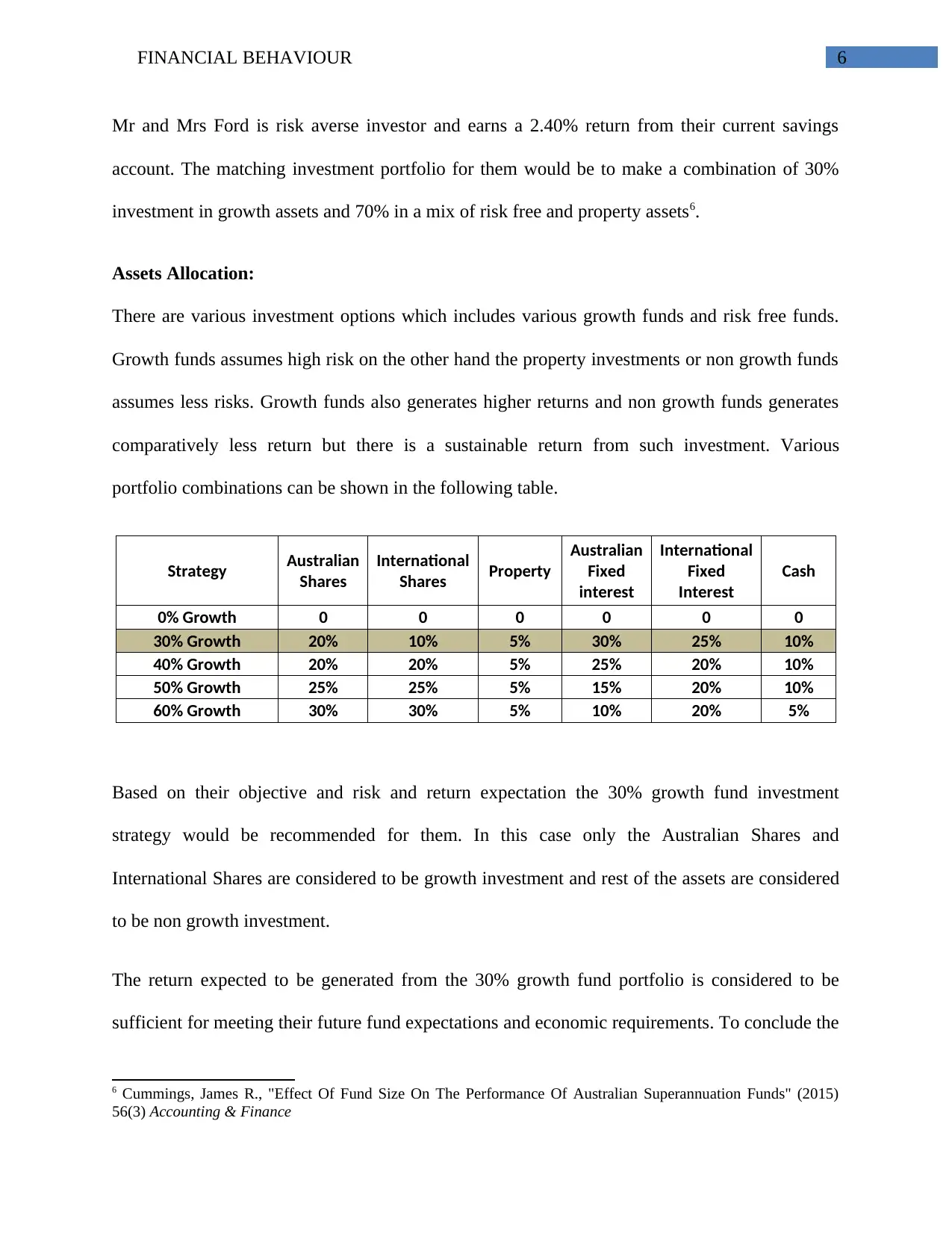
FINANCIAL BEHAVIOUR 6
Mr and Mrs Ford is risk averse investor and earns a 2.40% return from their current savings
account. The matching investment portfolio for them would be to make a combination of 30%
investment in growth assets and 70% in a mix of risk free and property assets6.
Assets Allocation:
There are various investment options which includes various growth funds and risk free funds.
Growth funds assumes high risk on the other hand the property investments or non growth funds
assumes less risks. Growth funds also generates higher returns and non growth funds generates
comparatively less return but there is a sustainable return from such investment. Various
portfolio combinations can be shown in the following table.
Strategy Australian
Shares
International
Shares Property
Australian
Fixed
interest
International
Fixed
Interest
Cash
0% Growth 0 0 0 0 0 0
30% Growth 20% 10% 5% 30% 25% 10%
40% Growth 20% 20% 5% 25% 20% 10%
50% Growth 25% 25% 5% 15% 20% 10%
60% Growth 30% 30% 5% 10% 20% 5%
Based on their objective and risk and return expectation the 30% growth fund investment
strategy would be recommended for them. In this case only the Australian Shares and
International Shares are considered to be growth investment and rest of the assets are considered
to be non growth investment.
The return expected to be generated from the 30% growth fund portfolio is considered to be
sufficient for meeting their future fund expectations and economic requirements. To conclude the
6 Cummings, James R., "Effect Of Fund Size On The Performance Of Australian Superannuation Funds" (2015)
56(3) Accounting & Finance
Mr and Mrs Ford is risk averse investor and earns a 2.40% return from their current savings
account. The matching investment portfolio for them would be to make a combination of 30%
investment in growth assets and 70% in a mix of risk free and property assets6.
Assets Allocation:
There are various investment options which includes various growth funds and risk free funds.
Growth funds assumes high risk on the other hand the property investments or non growth funds
assumes less risks. Growth funds also generates higher returns and non growth funds generates
comparatively less return but there is a sustainable return from such investment. Various
portfolio combinations can be shown in the following table.
Strategy Australian
Shares
International
Shares Property
Australian
Fixed
interest
International
Fixed
Interest
Cash
0% Growth 0 0 0 0 0 0
30% Growth 20% 10% 5% 30% 25% 10%
40% Growth 20% 20% 5% 25% 20% 10%
50% Growth 25% 25% 5% 15% 20% 10%
60% Growth 30% 30% 5% 10% 20% 5%
Based on their objective and risk and return expectation the 30% growth fund investment
strategy would be recommended for them. In this case only the Australian Shares and
International Shares are considered to be growth investment and rest of the assets are considered
to be non growth investment.
The return expected to be generated from the 30% growth fund portfolio is considered to be
sufficient for meeting their future fund expectations and economic requirements. To conclude the
6 Cummings, James R., "Effect Of Fund Size On The Performance Of Australian Superannuation Funds" (2015)
56(3) Accounting & Finance
Paraphrase This Document
Need a fresh take? Get an instant paraphrase of this document with our AI Paraphraser
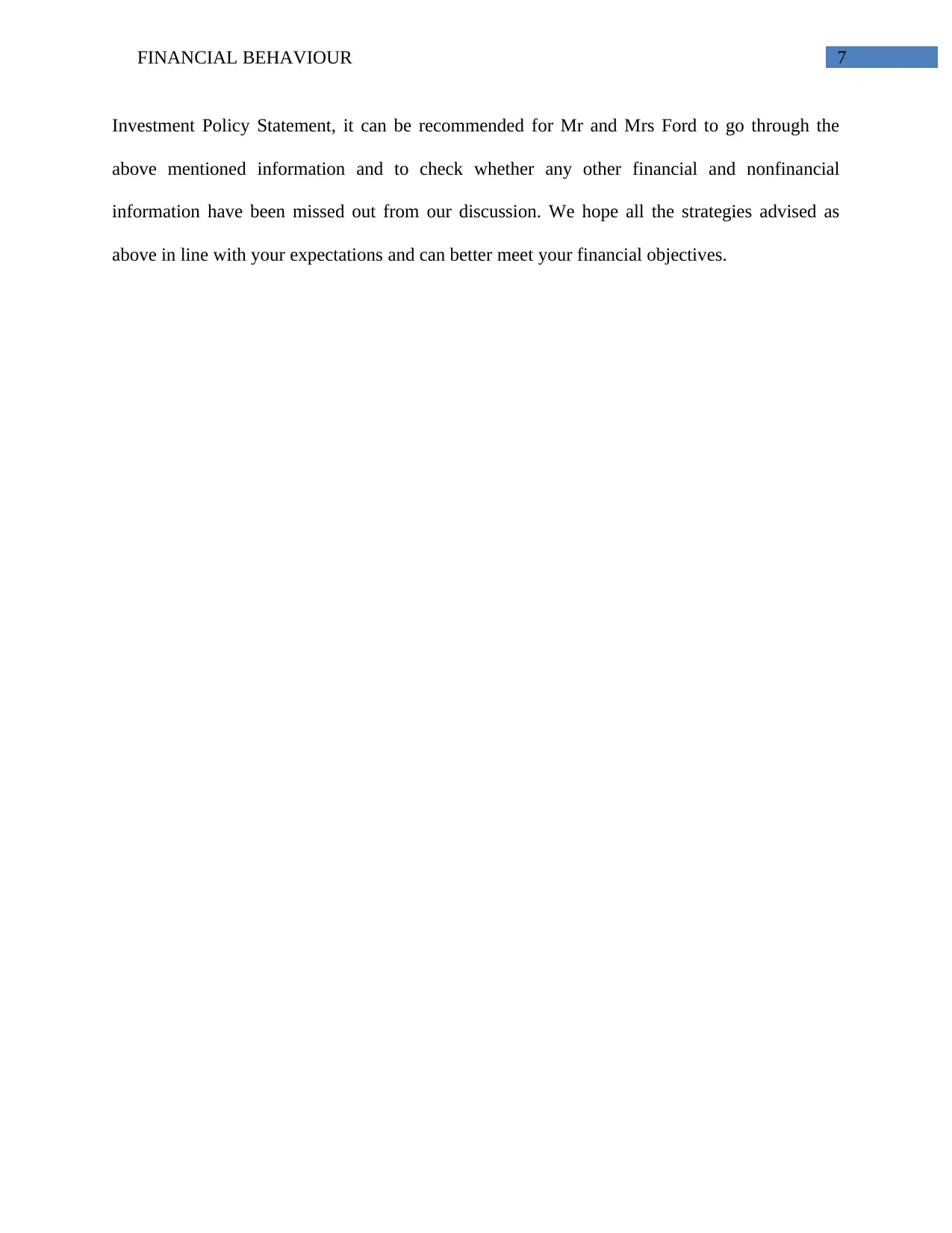
FINANCIAL BEHAVIOUR 7
Investment Policy Statement, it can be recommended for Mr and Mrs Ford to go through the
above mentioned information and to check whether any other financial and nonfinancial
information have been missed out from our discussion. We hope all the strategies advised as
above in line with your expectations and can better meet your financial objectives.
Investment Policy Statement, it can be recommended for Mr and Mrs Ford to go through the
above mentioned information and to check whether any other financial and nonfinancial
information have been missed out from our discussion. We hope all the strategies advised as
above in line with your expectations and can better meet your financial objectives.
1 out of 8
Related Documents
Your All-in-One AI-Powered Toolkit for Academic Success.
+13062052269
info@desklib.com
Available 24*7 on WhatsApp / Email
![[object Object]](/_next/static/media/star-bottom.7253800d.svg)
Unlock your academic potential
Copyright © 2020–2025 A2Z Services. All Rights Reserved. Developed and managed by ZUCOL.





